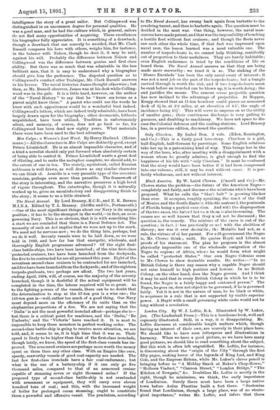London City. By W. J. Loftie, B.A. Illustrated by W.
Luker, jun. (The Leadenhall Press.)—This is a handsome book, well and copiously illustrated. Still, in a way, it is disappointing. Mr. Loftie discusses at considerable length matters which, though having an interest of their own, are scarcely in their place here. We should like to have seen letterpress and illustrations in harmony. When we have a good picture, as we have here many good pictures, we should like to read something about the subject. But this wish is often left ungratified. Mr. Loftie, for instance, is discoursing about the "origin of the City" through the first fifty pages, making havoc of the legends of King Lud, and King Cole, and the Empress Helena, while Mr. Luker's clever pencil is bringing before us "A Midday Snack at Baker's Chop-House," "Holborn Viaduct," "Cannon Street," "London Bridge," "The Kitchen of Newgate," &c. Doubtless Mr. Loftie is mostly in the right, though he minimises, we think, the early importance of Londinium. Surely there must have been a large native town before Aulus Plantius built a fort there. " Suetonius found that Londinium, though a large place, was of no strate- gical importance," writes Mr. Loftie, and infers that there was no bridge there at the time. Tacitus states that it was a large trading centre, and implies that it was too big to hold, being probably unwalled, with the small force that was at Suetonins's disposal. One of the best chapters in the book is that on "The Churches." Generally, Mr. Lof tie's views on archi- tectural matters are well worth considering, though he is inclined to be too severe. Something might be urged on behalf of some of the buildings on which he passes a sentence of unmitigated
condemnation. To put the case of the whole book very briefly, both draughtsman and writer have done well, but they have not worked together.—In this connection we may mention The "Church Bells" Album of City Churches (Church Bells Office). This consists of two parts. Twenty-five views of City churches are given in the first, two being allotted to St. Paul's, and two to the Temple Church. All these are to be found in the City proper. The second part contains as many more, but some of these belong to London without the walls. Each drawing is accompanied by appropriate letterpress, and a list of incumbents is added.



































 Previous page
Previous page